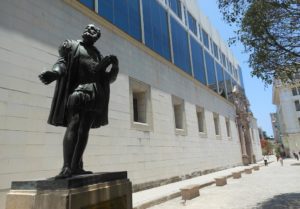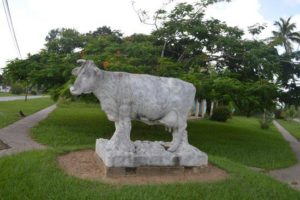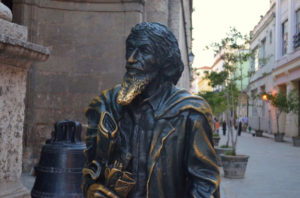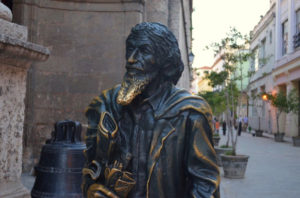 UNA VISITA A CUBA, EL PAIS DE LAS ESTATUAS.
UNA VISITA A CUBA, EL PAIS DE LAS ESTATUAS.
La ciudad de la Habana, es una capital de leyenda y hechizo, de encanto e historia, de viejos y nuevos monumentos, de estatuas famosas que recrean la mirada del caminante atento y divertido que recorren sus estrechas calles donde cada figura de bronce y mármol tiene historia propia; como diría nuestro Federico García Lorca, las estatuas de mi Habana tienen duende y andan de traviesas por toda mi ciudad.
Desde Monsieur de Paris (El Caballero de París) hasta John Lennon, aquel músico del cuarteto de Liverpool hoy sentado con piernas cruzadas en un banco de la calle 17 esquina a 6ª en el Vedado habanero, las estatuas han ocupado cada espacio turístico en la “Nueva Habana” que Eusebio Leal ha regado con verdadero escrutinio histórico en mi ciudad capital y sus alrededores para los turistas que visitan ésta.
Strauss, autor de uno de los más famosos vals de todos los tiempos, Danubio Azul, en la calle Línea y G; la estatua de don Quijote en la calle 23 y J; otro famoso de todos los tiempos, la figura de Hasecura Trunenaga, primer samurai japonés que visitara Cuba, tiene la suya en la Avenida del Puerto, más recientemente la de la Madre Teresa de Calcuta en el Jardín del antiguo Convento de San Francisco de Asís, ahora una sala de conciertos y museo, en La Habana Vieja.
No ya dentro de la ciudad sino en el municipio especial Isla de la Juventud, frente a la provincia habanera y visitada por muchos turistas, se ha erigido una estatua para recordar aquel bello ejemplar Holstein-Cebú que llegara al libro de los records mundiales Guinness al producir casi 25.000 litros de leche en 305 días de extracción; la vaca preferida de Fidel Castro, “Ubre Blanca”, cuya figura esculpida en blanco mármol descansa sobre un bello pedestal en Nueva Gerona.
Otras conocidas estatuas creadas para la atención de los visitantes a Cuba son los de Antonio Gades, Ernest Hemingway, Miguel Matamoros, Company Segundo, Gabriel García Márquez, Chopin, Cecilia Valdez, Bola de Nieve, Sancho Panza y el Quijote, Nicolas Guillen, Makarios y un sin numeros más.
Pero sería del todo injusto olvidar la estatua que descansa con sus dos viejas botas sobre adoquines adornando la calle frente al convento Franciscano de Asis, la de Monsieur de Paris (El Caballero de París), ese mismo nombre que trae a nuestra mente aquel otro histórico personaje parisino, hombre gentil y reservado también, que en tiempos de la revolución francesa fue descubierto por la curiosa dueña de su hospedaje al abrir su bien protegido maletín de trabajo y encontrando en él la hoja de la guillotina que utilizaba semanalmente en su habitual trabajo.
Nuestro Caballero de Paris (Monsieur de Paris), aunque apodado con el nombre de la capital francesa, era español. Su estatua, producción artística del escultor Villa Soberón, es la última creada para la bella Habana de mis recuerdos.
El Caballero habanero que recorría entonces las calles habaneras vestido de negro y capa al dorso del mismo color se llamó Xosé López Lledín, llegó desde España con apenas 14 años y por infortunios del destino fue a parar a una cárcel cubana de donde salió en las condiciones como se le vio andar por muchos años por las calles de La Habana, llevando sus miserias a cuestas pero con cierta hidalguía u orgullo, hasta 1977, fecha en que fue internado en el Hospital Psiquiátrico de Mazorra, donde murió en 1985. Sus restos descansan hoy a pocos pasos de donde se erigió su estatua junto a los de otros caballeros y nobles damas habaneras de la época.
Esta es la cruda historia de un país donde monumentos y estatuas son erigidas a famosos personajes, hasta animales, para servir de entretenimiento, un lugar de esparcimiento turístico de aquellos a quienes no les interesa conocer o quizás se empeñen en olvidar la trágica realidad de la Cuba actual.
 A VISIT TO CUBA, THE COUNTRY OF STATUES.
A VISIT TO CUBA, THE COUNTRY OF STATUES.
Havana, capital of legend and spell, of charm and history, of old and new monuments, of famous statues that recreate the gaze of the attentive and amusing walker who walks its narrow streets where each bronze and marble figure has its own history; As our Federico García Lorca would say, the statues of my Havana have a duende and they roam around my city.
From Monsieur de Paris (The Knight of Paris) to John Lennon, that musician of the Liverpool quartet today sitting cross-legged on a bench on 17th street, 6th street in Havana’s Vedado, statues have occupied every tourist space in the “ New Havana ”that Eusebio Leal has watered with true historical scrutiny in my capital city and its surroundings for the tourists who visit it.
Strauss, author of one of the most famous waltz of all time, Blue Danube, on Linea and G street; the statue of Don Quixote on 23rd and J streets; Another famous of all time, the figure of Hasecura Trunenaga, the first Japanese samurai to visit Cuba, has his on Avenida del Puerto, most recently that of Mother Teresa of Calcutta in the Garden of the former Convent of San Francisco de Asís, now a concert hall and museum, in Old Havana.
Not already inside the city but in the special municipality Isla de la Juventud, in front of the Havana province and visited by many tourists, a statue has been erected to remember that beautiful Holstein-Cebu specimen that reached the Guinness World Record Book at produce almost 25,000 liters of milk in 305 days of extraction; Fidel Castro’s favorite cow, “Ubre Blanca”, whose figure sculpted in white marble rests on a beautiful pedestal in Nueva Gerona, ah … past times of a revolution!
Other well-known statues created for the attention of visitors to Cuba are the Antonio Gades, Ernest Hemingway, Miguel Matamoros, Company Segundo, Gabriel García Márquez, Chopin, Sancho Panza y el Quijote, Bola de Nieve, Nicolas Guillen, Makarios, and countless others.
But it would be completely unfair to forget the statue that rests with its two old boots on cobblestones adorning the street in front of the Franciscan convent of Assisi, that of Monsieur de Paris (The Knight of Paris), the same name that brings to mind that other historical Parisian character, a gentle and reserved man too, who in times of the French Revolution was discovered by the curious owner of his hotel when he opened his well-protected work case and found in it the guillotine blade that he used weekly in his usual work.
Our Knight of Paris (Monsieur de Paris), although nicknamed with the name of the French capital, was Spanish. His statue, artistic production of the sculptor Villa Soberón, is the last one created for the beautiful Havana of my memories.
The Havana gentleman who then walked the streets of Havana dressed in black and a cape on the back of the same color was called Xosé López Lledín, he arrived from Spain at just 14 years old and, due to the misfortunes of fate, he ended up in a Cuban prison where he left in the conditions as he was seen walking for many years through the streets of Havana, carrying his miseries in tow but with a certain nobility or pride, until 1977, when he was admitted to the Psychiatric Hospital of Mazorra, where he died in 1985. His remains rest today a few steps from where his statue was erected along with those of other gentlemen and noble ladies of Havana of the time.
This is the harsh history of a country where monuments and statues are erected to famous characters, even animals, to serve as entertainment, a place of tourist recreation for those who are not interested in knowing or perhaps insist on forgetting the tragic reality of Cuba today.
Agencies/ Wiki/ Arnoldo Varona/ Internet Photos/ www.TheCubanHistory.com
THE CUBAN HISTORY, HOLLYWOOD.













